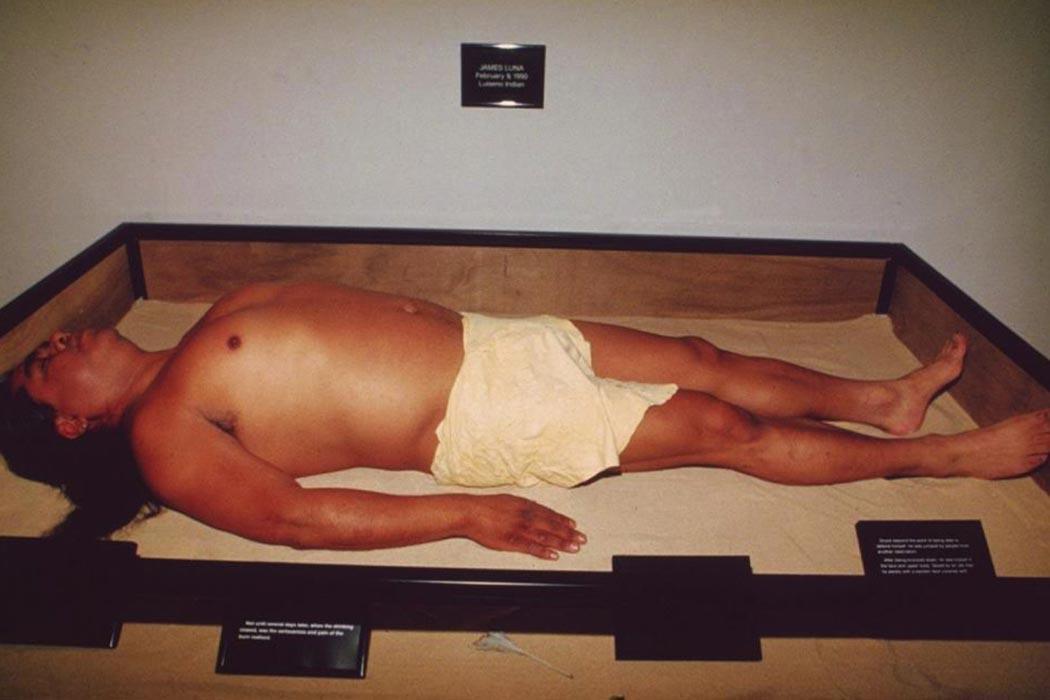In recent months, planners behind the music festivals Electronic Forest and Montreal’s Osheaga Music and Arts Festival have banned attendees from wearing Native American headdresses in order to take a stand against the cultural appropriation. Elsewhere, in schools and universities across the U.S., efforts to ban the use of Native American mascots to prevent the reinforcement of certain racial stereotypes have gained steam. Even Adidas has joined in the effort to eradicate these mascots from schools. But such work is not limited to the world of sports and music. Many artists have been working against appropriation and harmful stereotypes for a long time.
James Luna is a Luiseno Indian artist and activist who uses his performances, installations, and words to challenge the confines of art-historical and museum exhibition practices, questioning the ways that Native American Indians are often remembered, “honored,” and pictured in the white imaginary.
Luna is best known for his 1985-7 performance of “Artifact Piece,” during which he laid his own near-naked body in a display case at the Museum of Man in San Diego. In the case, he labeled scars and personal belongings much as the curator had labeled archaeological objects displayed in the museum. As a living, human artifact, he challenged exhibition practices that often relegate Native American culture to natural history museums, as if all that is left are objects from an extinct people, rather than showcasing contemporary art from a culture very much alive. His piece famously called attention to the way the largely white art world and historical narrative excludes, ignores, and re-imagines Native culture.
In “Blinded by the White: Art and History at the Limits of Whiteness,” Ellen Fernandez-Sacco examined Luna’s art and practice as a resistance to and of whiteness. “Luna uses his body as an intervention, as physical evidence that he is part of the American experience. The frame of the original work is changed, and the gestures open an alternative space, to reflect upon identity.” As viewers circled his “Artifact Piece,” they were shocked to realize he was breathing. His intervention served to challenge and rewrite historical narratives, as if to scream, “We are still here, living and breathing amongst you.”
Fernandez-Sacco looked to the way that whiteness is an invisible and presumed modifier both in the museum and at large. Luna challenges this presumption though. His works “in nontraditional spaces expose the violence in display practices and critique the transformation of humans into objects…In disrupting the observer’s expectations, Luna seeks to reveal the stakes involved in attending the museum.”
Fernandez-Sacco explained that Luna’s biting humor and larger artistic goal “undermines the viewer’s expectation of entertainment to provoke a critical dialogue that questions the role of the Indian stereotype in the imagination of the United States.”
He continues this theme in other works such as the poem, “I’ve Always Wanted to Be an American Indian,” published by Art Journal. In it, Luna pairs the text with photographs from his La Jolla reservation to call attention to age-old, white stereotypes and desires for an imagined Native life. In the beginning of the poem, Luna draws readers in with a white man saying to him, “Gee, I’ve always wanted to be an American Indian.” For years, white America has had an infatuation with being and playing Indian in culturally insensitive and largely uninformed ways, as seen with particular abundance in Indian Halloween costumes, in festival attendees and runway models cluelessly donning headdresses, and in decontextualized feathered decor amidst gourds at Thanksgiving celebrations. (For more on this historically recurring theme, read Philip J. Deloria’s Playing Indian, Adrienne Keen’s blog Native Appropriations, and the many articles on “The Cherokee Syndrome.”)
He continues, offering details about who lives at his reservation (Sioux, Navajo, Hopi, Cherokee, Mojave, Diegueno, Cupeno, Shoshone, Miwok, Wailaki, and Cahuilla), how large the reservation is (8,541.25 acres), and how many people live there (355). Next he details the many challenges those 355 residents have faced in the past year, including numerous deaths, illnesses, jailings, shootings, and more. He follows with the good news that these same residents have celebrated (including but not limited to) births, graduations, and the start of a volunteer fire department. Each page of text is interspersed with two or three photographs of buildings and the people living on the reservation. It is in his images and words that Luna personifies the data, putting faces to the usually faceless and largely nameless statistics.
He ends the poem cyclically, returning to the white American man longing to be Native American. Luna tears this uninformed desire apart, simply and succinctly:
There is much pain and happiness, there is success and there is failure, there is despair and there is hope for the future. Still I would live no place else because this is my home, this is where my people have come. I also know that this place, like other places, is the reality that we Indians live; this is it. This isn’t the feathers, the beads of many colors, or the mystical, spiritual glory that people who are culturally hungry want. Hey, do you still want to be an Indian?
Through physical and psychical interventions, James Luna’s work is powerful, challenging, and integral to expanding art history’s oft-constricting canon, exhibition practices, and imagined historical narratives.







